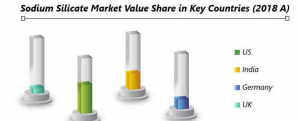If you’re interested in launching a manufacturing business producing Sodium Silicate, you’ll want to learn about the manufacture of this chemical. Generally referred to as water glass or liquid glass, it is used by manufacturers involved in textiles, pharmaceuticals, and the paper industries to produce a variety of products and processes.
Many industries employ sodium silicate in their production processes. Sodium Silicate is a white, dust-type chemical that can be colorless or slightly yellow. Its also known by chemists as sodium alkylate.
It can be in the form of dishwashing soap, steam sodium silicate, fluxing agent, food preservative, and desalination reagent. It is used by manufacturers in composite resins as a filler and other uses as well. Due to these uses, it’s also referred to by someone as white amorphous frit.
Start a Business in Chemical Industry Projects, Click Here
Silicate, sodium silicate, also originally has been used as a raw material since ancient times, and some civilizations produced tools and weapons from it. Romans and Chinese perfected that type of manufacture to advanced levels.
Read our Books Here: Chemical Technology (Organic, Inorganic, and Industrial), Fine Chemicals
Benefits:-
The benefits of starting a new manufacturing business in this compound are numerous. Producers obtain the white powder from a natural mineral called hydrated sodium calcium aluminosilicate. Besides waterproofing cement, industries use it in industrial paints, coatings, fireproofing materials, and fiberglass insulation.
Despite names like alkyl silicate or sodium aluminate, it contains no aluminum. Industries employ it as a waterproofing agent for cement, mortar, aqueous coatings, polyvinyl alcohol, and other materials. It usually forms fusible hydrated silica gel that can be easily incorporated into any desired material. Most production takes place in Europe and the United States.
Related Business Plan: Liquid Sodium Silicate from Caustic Soda & Sand
This is because the natural mineral that constitutes sodium silicate is abundant in these regions. South Africa and Europe contain a much higher concentration of this mineral than the rest of the world. Even so, industries also produce this substance commercially in other regions, such as Japan and China.
Common uses:-
Sodium Silicate uses most common use for Sodium Silicate is for fabric softeners such as Dove, Woolite, and Gain. The pulp and paper (papermaking) industry also uses sodium silicate. Chemical industries use it to create various products such as detergents, lotions, soaps, and other cleaning products.
Industries also use it in chemical feedstock applications to make fertilizers, specialty chemicals, and many other products. The glass industry relies on sodium silicate as a key compound because it contains sodium oxide and silica.
The liquid sodium Silicate has many uses, including iron deflocculated for water treatment plants, glass manufacturing, as well as the protection of fire, detergent aids, cement formulation, the use of drilling fluids, textile processing, desiccant, silica gel, and the production of ceramics for refractory use.
The sodium silicate solution is utilized to make a paper cement during the making of cardboard. Liquid glass is utilized to make a drilling fluid to aid in the stability of the borehole’s walls. In the automobile industry, it is employed as an engineered crack sealer as well as an exhaust system joint to repair the resonators, tailpipes, mufflers, and other parts.
Find Best Business ideas for your using our Startup Selector Tool
Outlook:-
Reactive silica, for which sodium silicate is the primary ingredient, is highly sought after in industries such as detergents, rubber, food and beverage, and paper and pulp. Manufacturers modify solutions containing soluble forms of the compound through methods like acid addition and ion exchange to produce silica sols, gels, and precipitated silica. These products serve many sectors, including water treatment, detergents, construction, tires, and more.
Demands:-
The increasing demand for sodium silicate in the electrode coatings as an adhesive agent is likely to have a positive effect on the growth of the industry. It can mix chemically into electronic coatings and then harden, increasing the overall durability of the coating. Furthermore, it provides excellent flux action on the cover for the welding rod. The growing demand for sodium silicate in welding applications will positively drive the development of the industry.
Rising demand for soluble silicates in soil treatment and stabilization will impact the development of the industry in the coming years. In addition, growing demand for sodium silicates in textiles to make dyes and peroxide bleach will positively drive the industry’s growth.
Read Similar Articles: Chemical Industry
The rising demand for its use as an adhesive or bonding agent is predicted to impact the expansion of the paper industry. In addition, growing demand for its coating, bleaching, and sizing applications is anticipated to boost overall consumption in the coming eight years.”
Sodium silicate produces precipitated silica as one of its primary products, and industries widely use it in manufacturing silicone rubber compounds. It lowers the total price for silicone elastomers. Furthermore, it enhances the fatigue resistance, tensile strength, and durability of elastomers, which will likely secure a significant market share in the elastomer industry.
The market shows an extremely high level of integration. Companies that produce sodium silicate also supply soda ash, a vital raw material for manufacturing the product. Furthermore, manufacturers use a significant portion of sodium silicate—particularly liquid sodium silicate—to produce downstream products such as precipitated silica gels and zeolites, meeting the growing consumer demand
Related Feasibility Study Reports: Chemicals (Organic, Inorganic, Industrial)
Asia Pacific, especially China, will likely remain an important market player due to the rapid growth of end-user industries such as automotive, oil and gas, paper, and textiles across the continent. Major manufacturers from advanced economies plan to expand their sales networks across emerging regions, including the Middle East, Africa, and the Asia Pacific, to strengthen their presence in the market.
Conclusion
Manufacturers can produce sodium silicate from two components: water and sodium compounds such as soda ash, or from natural ammonia-based material.

The experts from NPCS have examined and predicted the size of the global sodium silicate market. They have also done a great job categorizing and forecasting it based on global and local distribution. To assist startups and businesses, NPCS has identified demand and drivers that affect the market worldwide. The study highlights aggressive tendencies, including expansions, new products, mergers, and acquisitions.
Frequently Asked Questions
What is sodium silicate?
Sodium silicate is a chemical compound, appearing as a white, dust-like substance that can be colorless or slightly yellowish. Manufacturers also produce it as a white powder from a natural mineral known as hydrated sodium calcium aluminosilicate.
2. What are other names for sodium silicate?
People commonly call sodium silicate water glass or liquid glass. Some also refer to it as sodium alkylate, but even when they use names like alkyl silicate or sodium aluminate, the compound contains no aluminum.
Where do we apply Sodium silicate?
Various industries apply sodium silicate in a wide range of ways. Key uses include:
Detergents and Cleaning Products: It is a component in fabric softeners (like Dove, Woolite, and Gain), detergents, lotions, and soaps.
Pulp and Paper Industry: Manufacturers use it as an adhesive to make paper cement for cardboard and for applications in coating and bleaching.
Construction and Manufacturing: It serves as a waterproofing agent for cement and mortar, a fireproofing material, and a component in industrial paints and fiberglass insulation. Industries also use it to manufacture glass, ceramic, and refractory materials.
Automotive Industry: Manufacturers employ it as a crack sealer for exhaust systems, including resonators, tailpipes, and mufflers.
Chemical Production: It is a key ingredient for producing precipitated silica, silica sols, silica gels, fertilizers, and other specialty chemicals.
Other Applications: It functions as a filler in composite resins, a lubricant, an industrial abrasive, an adhesive for electrode coatings, a drilling fluid in the oil and gas industry, and in textile processing for dyes and peroxide bleach.
Manufacturers can produce sodium silicate from water and sodium compounds such as soda ash. Another primary raw material mentioned is silica.







